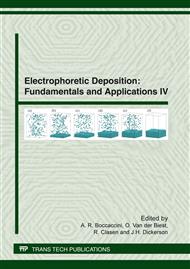p.127
p.135
p.141
p.149
p.155
p.163
p.169
p.175
p.181
Macro- and Microscale Fabrication by Field Assisted Nanoparticle Assembly - The Challenging Path from Science to Engineering
Abstract:
Local electrophoretic deposition of alumina nanoparticles under external DC electric field conditions with submerged impinging jet type capillaries arranged at ion exchange membrane substrates is presented. In order to evaluate particle deposition mechanisms a mathematical model is derived describing electroosmotic pumping of electrolyte through a micrometre scaled channel. The system is governed by surficial charge discontinuities and modeled by coupled mass balances, Ohmic law, Navier Stokes, and Nernst-Planck equations. Based on the boundary conditions of bulk convective electrodiffusion the effect of the imposed surface potential on the fluid flow behaviour and on particle tracing characteristics is studied by means of numerical analysis. The following findings have been obtained. At the corner edges of the charged surficial boundaries micro-vortices are generated to build up local stagnation points onto the modeled membrane surface. Particle tracing analysis reveal that the particle movement is caused by mass transport within the membrane directed velocity field to the stagnation point. The complex electrokinetics and electrohydro-dynamics suggest further investigations at membrane pore sizes in the range of the Debye-length to model the non-linear current-voltage characteristic that has already been experimentally proven for these kind of membrane EPD systems.
Info:
Periodical:
Pages:
155-162
Citation:
Online since:
March 2012
Authors:
Price:
Сopyright:
© 2012 Trans Tech Publications Ltd. All Rights Reserved
Share:
Citation:


